Analysis of the ending of No Man's Sky: universe simulation theory (spoiler)
“Come on, there are other worlds besides these.”
Stephen King. Dark tower
After many hours spent in careful exploration of the universe, I finally went to the center of the galaxy and revealed all its secrets. The ending was so incomprehensible that I would not be surprised if, after some time, it stirs up the gaming community and generates a lot of discussion. In this material I will touch on all the spoiler-y points, starting with the origins of the mysterious Atlas, the mysterious roles of Nada and Polo, as well as the theory of the universe as a product of a computer simulation of a certain super-race that is actively exploited.
If you value plot twists and turns and would like to thoroughly study everything yourself, this material is not for you. But if you never intended to spend 30+ hours on the passage, but you are interested in knowing how it all ended and what is the cultural and scientific influence of society on this game - stay with us!
Meaning of the Atlas Path
The plot development begins from the moment the player chooses to follow the Path of the Atlas, which one day leads him to a diamond-shaped structure floating in space. According to the game's creator, Sean Murray, it is something like "the central computer system in which all data is stored". In it, a gigantic continuously pulsating ball appears before the Wanderer (this is one of the names used in relation to the main character - I will refer to him further in the text). This sphere, the "remains of Atlas", offers "true understanding of all things". The wanderer immediately asks himself whether this is true or not. “some vast simulation created by another intelligence”. Here the player is faced with a choice: to agree to a seemingly dubious proposal or to go his own lonely way. If you agree, then your journey to the center of the galaxy has begun.
Despite the fact that the Atlas Path is laid out for you on a rather narrow (in relation to the scale of the game universe) “path” leading to other spheres, from time to time you will be able to get into cosmic anomalies and meet there with the Priest Entity Nada and Specialist Polo. Both of these intelligent creatures overcame the language barriers that separate the creatures that inhabit the universe. With each new visit, Nada offers the player all possible assistance - she replenishes some of the resources necessary for hyper-jumps, lays out on the map the shortest path to a black hole (traveling through them brings the main character closer to the goal), or gives advice on how to get to the next “remains of the Atlas” .
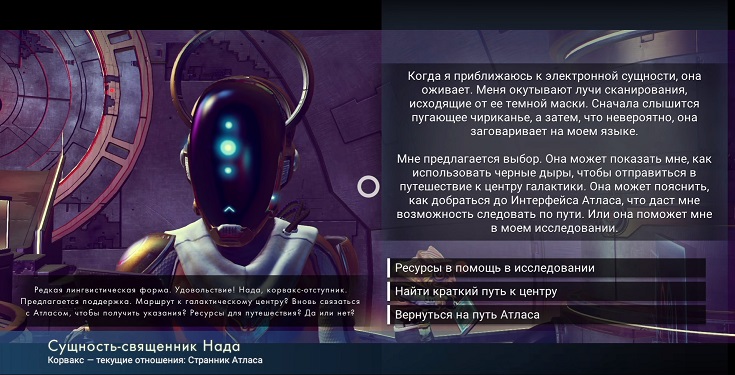
Ultimately, in order to be able to reach the center of the galaxy, you will have to collect and then sacrifice 10 Atlas stones given out by the spheres. But instead of learning all the secrets of the universe there, you actually start all over again - the mysteries of the origin of the Atlas remain unsolved, and the main character regains consciousness on a planet abandoned by the gods, discovering that his ship and equipment are in critical condition. Instead of ending, it begins again - in a very real sense - sending the player on a new journey. Let's try to figure out why.
What is Atlas?
To unravel the thick tangle of secrets that leads us to an ambiguous ending with Ariadne's thread, we must first understand what Atlas is. In the later stages of the game, the Wanderer refers to the creators of his world as “to weary minds, enslaved by their own reality just as I am enslaved by this one”. Thus, he already recognizes their authorship of the “model”, which is the universe. The only thing that remains unclear is: was Atlas directly the creator, or was he himself created by a higher intellect?
At the beginning of the game, he leads the Wanderer to one of the alien monoliths, scattered in great numbers across the planets. After agreeing to cooperate with Atlas, the main character observes "lines of code, lines of numbers, then a strange connection between them". This is the first hint of the true essence of the universe, which I will talk about in detail later.
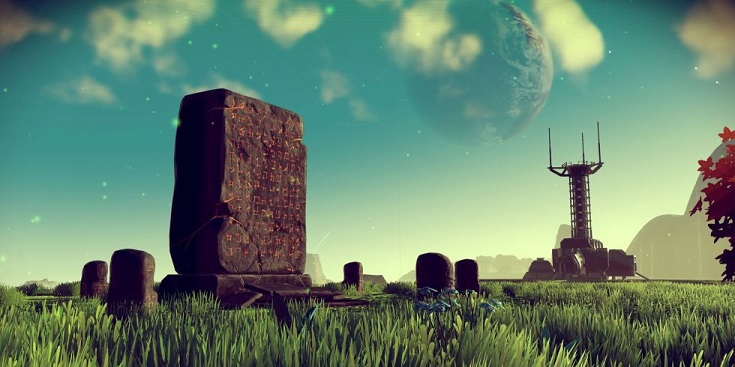
Universe as virtual reality
This year, a significant number of prominent scientists have coalesced around the theory of a simulation universe. It is based on the assumption that our entire Universe is the result of a computer simulation program created by a more advanced civilization. This means that all of us are in fact not at all intelligent beings with free will, but just lines of code merging into its general mass, which embodies the world around us. This idea was supported by the famous astrophysicist Neil deGrasse Tyson (you may be familiar with him from an equally popular meme), as well as the founder of SpaceX, Elon Musk. The latter even stated that the probability of the opposite happening is one in billions.
And if you take into account Musk's other comments about the simulation universe theory, its relevance becomes obvious. During the Code Conference earlier this year, Elon used video games as an example to explain why he believes the theory is true. He explained that if you trace the development trajectory of video games from the earliest to the modern, you can see a huge leap in the quality of the technologies used. Musk also noted that if this trend remains unchanged, then in 10,000 years, video games will become indistinguishable from reality.
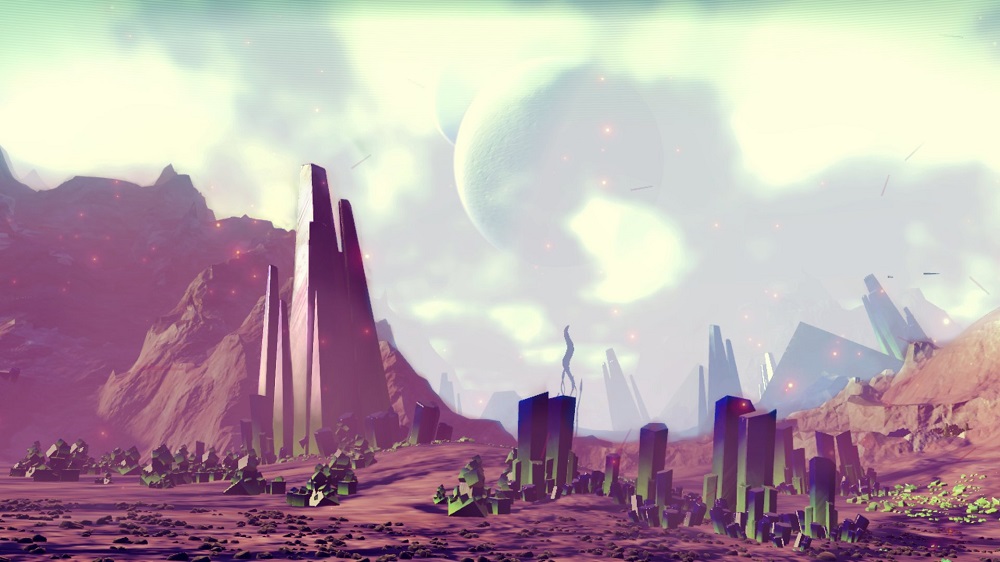
The young billionaire was inspired by the ideas of the Swedish philosopher and Oxford University professor Nick Bostrom, who in 2003 first introduced the hypothesis of a simulation universe to the scientific world. According to him, someday in the distant future, “super-people” will definitely begin to conduct so-called “simulations of the lives of their ancestors.” The proof of this hypothesis lies in the statement that we too will someday be able to create simulacra universes. Let me remind you that in our previous article we already called this game the first to reliably display the world around us in its entirety.
Despite the fact that Bostrom ultimately abandoned his own theory, admitting its inconsistency due to the lack of obvious evidence in its favor, it remains popular enough to at least find itself in a recently released game. During one of the meetings with the “remains of Atlas,” the Wanderer reports: “I'm afraid I've seen too much. The code that permeates the Universe appears to me as half-forgotten visions. An artificial existence controlled by unified, aggregate algorithms. A program as endless as existence itself. I pull back the curtain on reality, and what I see horrifies me."
Another clear hint that the universe is not as real as it seems to its inhabitants. It is only an illusion, and the Traveler follows the Path of the Atlas to destroy it. And the most interesting fact is that we, as players in , already know that it exists only as a virtual reality. In fact, we have already become “super-people” who gave life to this universe and the Wanderer traveling through it. But who is the Wanderer then?
Artificial intelligence
As he approaches the end of his journey, the main character finally comes to understand his place in the world. He says: “I have become a machine, I am the observed and the observer. The universe was created for my travels. It is built around my Path.”
The word “machine” in this case implies more of an android, a humanoid creature whose actions seem free, but are actually controlled from the outside. In the case of the Traveler, the player takes on the role of this external force, although the Traveler is unaware of this until later encounters with Atlas. In this he differs significantly from other inhabitants of the universe - at least he is destined to learn about his destiny.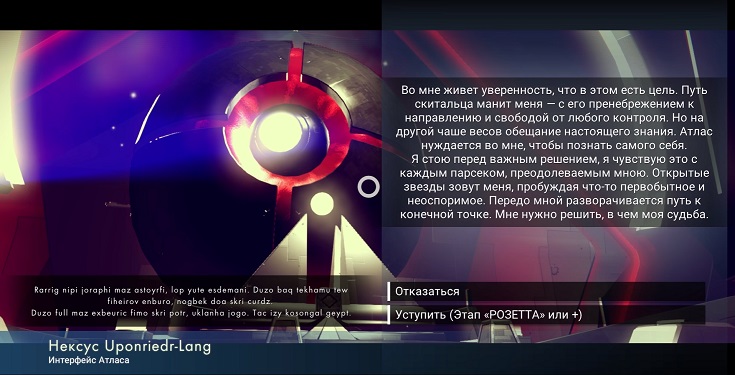
But why does the player control the Traveler at all? Well, he himself answers this question with the phrase about the “observer” and the “observed.” His role in this universe is to be a conductor of impressions about it for the player. However, gradually following the Path of the Atlas, he receives more and more frightening information about himself, his neighbors in life and the sad truth hidden behind the beautiful picture.
In this case, one cannot help but note a contradiction: why does this computer program allow one of its “wards” to become aware of themselves?
Nada and Polo
At certain points in the game, the only way to continue the Path of the Atlas is to get into the cosmic anomaly to the Priest Entity Nada and the Specialist Polo. As the name suggests, this anomaly should not initially exist in the universe at all. This idea is confirmed by Nada at the second meeting with the Wanderer with the following phrase: “Simulation Creator, Friend or Foe? Necessary paranoia. Galaxy, cause and effect, individuality, statistical anomaly - Nada error. Do you believe Nada? Should I trust you?
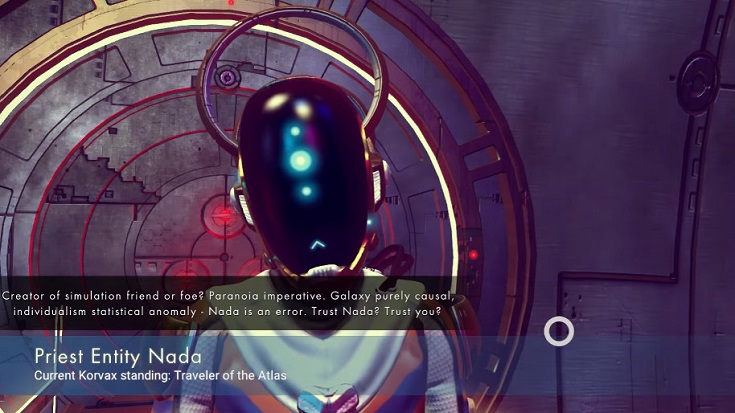
Thus, Nada confirms that the world around us is nothing more than an illusion. He calls himself an error in the code, explaining the existence of the galaxy as a cause-and-effect relationship, and any manifestation of individuality as an error in statistics. If the universe really is a computer simulation, then Nada and his companion Polo, fluent in the Traveler's native language, are both bugs in its code. In the same dialogue thread, the Wanderer makes a remark regarding Nad's words: “his reasoning is becoming more and more convincing”. He adds: “They found no place in the galaxy for free will or anything at all that is not limited by straightforward cause-and-effect relationships. Their concern is that we are all pawns in the games of the higher intelligence that created us - puppets dancing on strings. And Nada suspects me. I am distorted. Am I also a puppeteer?
From conversations between the Traveler and Nad, it becomes clear that the Priest Entity is gradually learning more and more about the true essence of the universe - he is even able to manipulate its source code, causing space-time distortions (black holes). Nada becomes a supreme being in the simulation, but becomes increasingly suspicious of the Traveler as their relationship develops. In turn, Korvas, the native race of Nada, treats him more and more hostilely, explaining this with the desire to destroy the Self-Aware Entity.
Despite the growing anxiety between the Traveler and Nada, the latter still helps the former on the Atlas Path to the center of the galaxy. So, does this mean that Atlas does not aim at achieving self-awareness for the Traveler, and this is just the unfortunate consequences of his communication with Nada, a bug in the code?
The center of everything
After the player has made enough hyper jumps, collected 10 Atlas Stones, and reached the final station, they are finally given the opportunity to travel to the center of everything. At the same time, the Stranger says: “A new star was born on the outskirts of the Galaxy. The new wanderer will find himself there. I am special. I clearly see the fabric of space, this whole simulation and the black holes in it. Perhaps I will find answers there."
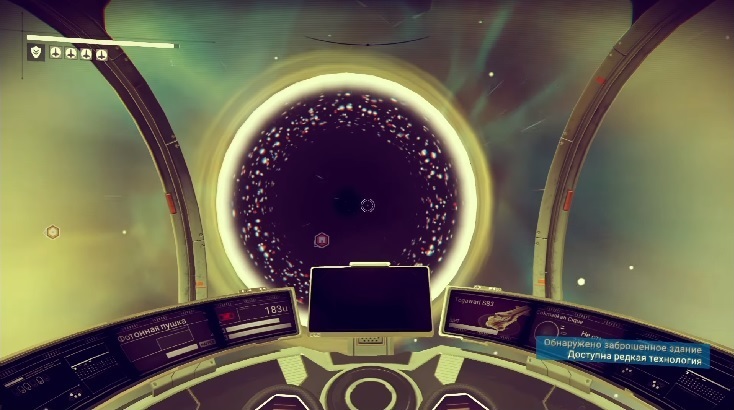
The Wanderer's words become prophetic, because as a result of a journey to the center of the Galaxy, the player again finds himself on an abandoned planet near the crash site of his ship. So what does this mean?
At first I thought, based on the Wanderer's comments about "new traveler", that I was placed into the essence of a completely new character while the previous protagonist disappeared into the algorithms of the universe. This theory almost immediately ran out of steam when I looked at the inventory and realized that I had kept the same exosuit, spaceship and acquired property. Everything led to the fact that I continued the game for the same Wanderer. The apogee of understanding shortly before this was the inscription in the center of the screen: "A new galaxy has been discovered..."

Which gave rise to my latest theory: the expansion of the universe depends only on the Traveler heading to all new galaxies, and each of them is created for the sole purpose of obtaining impressions for the player. This means that the protagonist’s belief in his own free will has no basis, and his fate is not at all a journey to the center of the world to the secrets hidden there, but an increase in our ability to explore the game. Like other video games, the Wanderer is just a tool to achieve certain goals.
Our whole life is a game?
Thus, it appears as a computer simulation of the universe, whose plot is centered around the psychological trauma of realizing the unreality of the world around us. In my opinion, Hello Games created a project that directly showed what it is like to create a procedurally generated reality and populate it with characters who gradually come to understand that they are nothing more than artificial intelligence.
Nada describes the Wanderer "distortion", hinting that he has been given the power to tug the universe's strings of code. This is partly true. The wanderer is both cause and effect, he knows that he is important to this world and that it was built for his sake. His mistake lies in thinking that traveling to the center of the galaxy will answer all his questions. But in fact, it turns out to be just a tool for creating new game content.
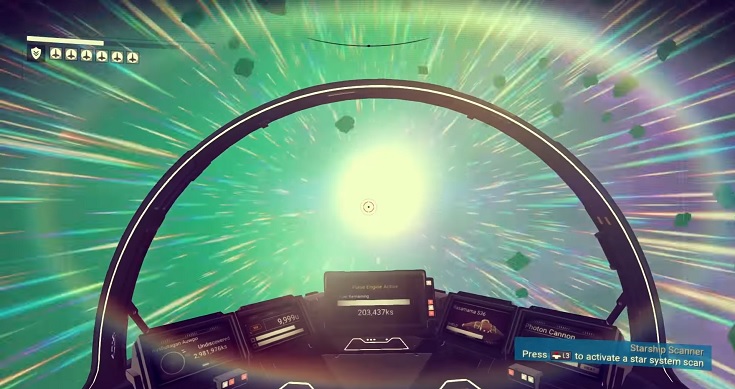
Tragic, isn't it? The wanderer believed that he would reveal all the secrets and gain the highest knowledge about the structure of the world and his own destiny. And the end of a long journey leads him to a new beginning. He truly believed that he could transcend the limits of the universe and get rid of limitations, but his real destiny is to repeat the same predetermined cycle forever.
This is a game about the consequences of realizing that you are not a player in it, but a weak-willed character. And if you believe Elon Musk, each of us has yet to experience this in our own skin.






